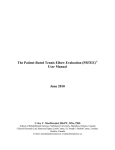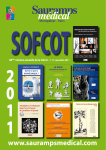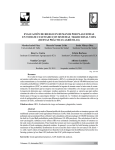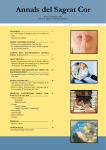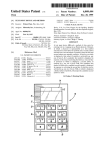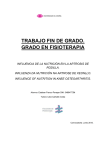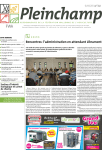Download The Patient-Rated Wrist Evaluation (PRWE) User Manual December
Transcript
The Patient-Rated Wrist Evaluation (PRWE)© User Manual December 2007 © Joy C. MacDermid, BScPT, MSc, PhD School of Rehabilitation Science, McMaster University, Hamilton, Ontario, Canada Clinical Research Lab, Hand and Upper Limb Centre, St. Joseph’s Health Centre, London, Ontario, Canada E-mail: [email protected] or [email protected] Table of Contents Introduction What is the PRWE? ......................................................................................……… p. 3 Objectives of the PRWE …………………………………………………………... p. 3 Instrument Development Designing the PRWE………………………………………………………………. p. 4 Testing the PRWE…………………………………………………………………..p. 4 How to Score the PRWE Computing the subscales ………………………………………………………….. p. 6 Computing the total score……………………………………………...................... p. 6 Sample Scoring ……………………………………………………………………. p. 6 Interpretation ………………………………………………………………………. p. 7 Common Questions ………………………………………………………..……………… p. 8 Instrument Properties and Outcome Studies Table 1 – Reliability …………………………………………………..................... p. 10 Table 2 – Validity …………………………………………………………………. p. 11 Table 3 – Responsiveness …………………………………………………………. p. 14 Table 4 – Comparative Data ………………………………………………………. p. 15 Modified Version: The PRWHE …………………………………………………………..p. 20 Bibliography of Published Studies …………………………………………........................p. 21 Page 2 Introduction What is the Patient-Rated Wrist Evaluation (PRWE)? The PRWE is a 15-item questionnaire designed to measure wrist pain and disability in activities of daily living. The PRWE allows patients to rate their levels of wrist pain and disability from 0 to 10, and consists of 2 subscales: 1) PAIN subscale (0 = no pain, 10 = worst ever) ¾ Pain - 5 items 2) FUNCTION subscale (0 = no difficulty, 10 = unable to do) ¾ Specific activities - 6 items ¾ Usual activities - 4 items In addition to the individual subscale scores, a total score can be computed on a scale of 100 (0 = no disability), where pain and function problems are weighted equally (see “How to Score the PRWE” for detailed scoring instructions). The PRWE provides clinicians with a standardized outcome tool that is easy to administer and score in the clinic, and complements traditional impairment and radiographic measures. The PRWE has been used to assess wrist-related pain and disability in various populations (see Table 4 for comparative data), and its reliability (Table 1), validity (Table 2), and responsiveness (Table 3) have been tested and reported in published studies. Objectives of the PRWE 1) To determine level of wrist disability 2) To set treatment goals 3) To determine whether change has occurred 4) To communicate in a meaningful way to payers Page 3 Instrument Development Designing the PRWE Active members of the International Wrist Investigators were surveyed by mail to help define the content and structure of the PRWE. Physicians were interested in using outcome measures and the response rate was 66% (n=100). Range of motion, radiographs, and grip strength were commonly used as objective measurements in clinical practice and pain, ability to do work and daily activities were frequently used to make subjective evaluations of a patient’s outcome. There was no standardized patient-rating scale that can quantify wrist pain and disability, and general health surveys such as the SF- 36 were too long and did not address issues regarding the wrist. Using the survey information obtained from the clinicians, a new instrument was developed that was designed to measure the status of the affected wrist; simple, brief, and easy to score; and measured the primary constructs of pain and disability of daily living separately. Scale items were generated using information obtained from patient and expert interviews, biomechanical literature, and other questionnaires. Items were reduced and refined through expert interviews and pilot testing on small groups of patients. The pain subscale was designed to be sensitive to mild pain (i.e., pain that only occurs with activity), as well as more severe pain (i.e., pain that occurs at rest). The function items must be commonly performed with either hand, performed by a majority of patients, and easy to comprehend by most respondents. The specific function items were comprised of activities involving wrist motion and strength that may be affected by various wrist pathologies. The usual function items covered 4 domains—self-care, work role, home life, and recreation—and were designed to assess the patient-specific role limitation. Expert consensus and statistical analyses of pilot data were used to select the "best" items for the subscales. To keep the instrument brief and easy to use in a clinic, the questionnaire format was limited to five pain questions and ten function questions. A 0 to 10 scale was selected because a numeric scale is more acceptable to patients, easier and score, and more responsive to change. A total score out of 100 can be computed by equally weighting the pain score (sum of five items) and the disability score (sum of ten items, divided by 2). The reliability of the pain and disability subscales and total scores are sufficiently high that they can be used separately in certain applications. Testing the PRWE A test-retest reliability study was conducted on patients with distal radius (n=64) or scaphoid (n=35) fractures. The total PRWE score’s test-retest reliability was excellent over both the short term (2-7 days, ICC > = 0.90) and the long term (1 year, ICC = 0.91). The pain subscale also had excellent short-term and long-term reliability (ICC = 0.90, 0.91, respectively). The function subscale demonstrated excellent short-term reliability (ICC > = 0.88) and moderate long-term disability (ICC = 0.61). Page 4 For the validity study, patients with distal radius (n=101) and scaphoid fractures (n=35) completed the PRWE and the SF-36, and had their grip strength, dexterity, and range of motion tested at baseline, two-month, three-month, and six-month follow-ups. Improvements in the PRWE and SF-36 scores of distal radius group over time were evaluated to assess construct validity. The PRWE had a statistically significant 74% improvement over 6 months, whereas the SF-36 physical summary score had a statistically significant 16% improvement. To determine the criterion validity, Pearson correlations were conducted between the PRWE and the SF-36 subscales or impairment measurements. Moderate correlations were found between the PRWE total and impairment measures (r = -0.52, -0.61, for radius and scaphoid groups, respectively). The PRWE scores correlated higher with the SF-36 physical component summary scores (r = -0.46 to -0.63) than the SF-36 mental component summary scores (r = -0.30 to -0.41). (Reference: MacDermid et al., 1998 (15)) Page 5 How to Score the PRWE *To minimize nonresponse, check forms once patients complete them. Computing the Subscales Pain Score = Sum of the 5 pain items (out of 50) Best Score = 0, Worst Score = 50 Function Score = Sum of the 10 function items, Divided by 2 (out of 50) Best Score = 0, Worst Score = 50 Computing the Total Score Total Score = Sum of pain + function scores Best Score = 0, Worst Score = 100 Note: responses to the fifteen items are totaled out of 100, where pain and disability are equally weighted Sample Scoring Name: Date: PATIENT RATED WRIST EVALUATION The questions below will help us understand how much difficulty you have had with your wrist in the past week. You will be describing your average wrist symptoms over the past week on a scale of 0-10. Please provide an answer for ALL questions. If you did not perform an activity, please ESTIMATE the pain or difficulty you would expect. If you have never performed the activity, you may leave it blank. 1. PAIN Rate the average amount of pain in your wrist over the past week by circling the number that best describes your pain on a scale from 0-10. A zero (0) means that you did not have any pain and a ten (10) means that you had the worst pain you have ever experienced or that you could not do the activity because of pain. Sample scale û 0 1 2 3 4 5 6 7 8 9 10 No Pain Worst Ever RATE YOUR PAIN: At rest 0 1 2 3 4 5 6 7 8 9 10 When doing a task with a repeated wrist movement 0 1 2 3 4 5 6 7 8 9 10 When lifting a heavy object 0 1 2 3 4 5 6 7 8 9 10 When it is at its worst 0 1 2 3 4 5 6 7 8 9 10 How often do you have pain? 0 1 2 3 4 5 6 7 8 9 10 Never Always Please turn the page.......... Pain score = 1 + 2 + 7 + 9 + 5 = 24/50 Page 6 2. FUNCTION A. SPECIFIC ACTIVITIES Rate the amount of difficulty you experienced performing each of the items listed below - over the past week, by circling the number that describes your difficulty on a scale of 0-10. A zero (0) means you did not experience any difficulty and a ten (10) means it was so difficult you were unable to do it at all. Sample scale û 0 No Difficulty 1 2 3 4 5 6 7 8 9 10 Unable To Do Turn a door knob using my affected hand 0 1 2 3 4 5 6 7 8 9 Cut meat using a knife in my affected hand 0 1 2 3 4 5 6 7 8 9 10 10 Fasten buttons on my shirt 0 1 2 3 4 5 6 7 8 9 10 Use my affected hand to push up from a chair 0 1 2 3 4 5 6 7 8 9 10 Carry a 10lb object in my affected hand 0 1 2 3 4 5 6 7 8 9 10 Use bathroom tissue with my affected hand 0 1 2 3 4 5 6 7 8 9 10 B. USUAL ACTIVITIES Rate the amount of difficulty you experienced performing your usual activities in each of the areas listed below, over the past week, by circling the number that best describes your difficulty on a scale of 0-10. By “usual activities”, we mean the activities you performed before you started having a problem with your wrist. A zero (0) means that you did not experience any difficulty and a ten (10) means it was so difficult you were unable to do any of your usual activities. Personal care activities (dressing, washing) 0 1 2 3 4 5 6 7 8 9 Household work (cleaning, maintenance) 0 1 2 3 4 5 6 7 8 9 10 10 Work (your job or usual everyday work) 0 1 2 3 4 5 6 7 8 9 10 Recreational activities 0 1 2 3 4 5 6 7 8 9 10 Function Score = (3 + 4 + 3 + 7 + 8 + 4 + 1 + 3 + 4 + 7) / 2 = 22/50 Total Score = 24 + 22 = 46/100 Interpretation ¾ The total PRWE score rates pain and disability equally. ¾ Higher score indicates more pain and functional disability (e.g., 0 = no disability). Page 7 Common Scoring 1) How are missing data treated? If there is an item missing, you can replace the item with the mean score of the subscale. 2) What if patients leave the question blank because they cannot do it? Make sure the patients understand that they should have answered “10” for the item and make corrections, if necessary. 3) What if patients rarely perform the task? If patients are unsure about how to answer a task that is rarely performed, encourage them to estimate their average difficulty. Their estimate will be more accurate than leaving the question blank. 4) What if patients do not do the task? If patients never do the task, they should leave the question blank. Page 8 Instrument Properties and Outcome Studies Reliability Test-Retest Reliability: the stability of the instrument over time. Standard Error of Measurement: the confidence around the value of the score. Minimum Detectable Change: the smallest real difference in score. Minimal Clinically Important Difference: the smallest difference in score that is considered important or beneficial. Validity Content Validity: the extent to which the instrument adequately covers the concepts of interest. Construct Validity: the extent to which the instrument corresponds to theoretical constructs. Criterion/Concurrent Validity: the extent to which the instrument relates with a gold standard or more established measure. Responsiveness (or Longitudinal Validity) Responsiveness: The ability of the instrument to detect change. Page 9 Table 1 - Reliability of the PRWE in Published Studies Study MacDermid et al., 1998 (15) Schmitt & Di Fabio, 2004 (19) Population Type PRWE Results Comparators 28 acute Colles (10M, 18F; Age=60.3 (11.2)); 36 treated Colles (12M, 24F; Age=44.7 (10.2)); 35 one-year Scaphoid (34M, 1F; Age=34.0 (10.0)) Short-Term (2-7 days) T-R reliability Acute and Treated Colles: Total ICCs > 0.90 Pain ICCs > 0.90 Function ICCs > 0.85 SF-36 Long-Term (1-year) T-R reliability Scaphoid Group: Total ICC = 0.91 Pain ICC = 0.90 Function ICCs > 0.61 ICC = 0.19-0.89 211 patients (50.2% F; age=47.5 (18-88)) with musculoskeletal disorders; Mean follow-up = 3 months (n=20) T-R reliability ICC = 0.91 DASH ICC = 0.81 SF-12 PCS ICC = 0.86 SEM 5.22 5.86 3.53 MDC, 90% 12.2 13.7 8.2 MID 24.0 17.1 7.3 Legend: F = female; ICC = intraclass correlation coefficient; M = male; MDC = minimum detectable change; MID = minimal important difference; SEM = standard error of measurement; T-R reliability = test-retest reliability Page 10 Table 2 - Validity of the PRWE in Published Studies Study MacDermid et al., 1998 (15) Jupiter et al., 2002 (6) Karnezis et al., 2002 (7) Population Type 101 patients (31M, 70F; Age=50 (16)) with distal radius (R) fractures; 35 patients (34M, 1F; Age=34 (10)) with scaphoid (S) fractures Construct Improvement over time 20 patients (6M, 14F; Age=68 (60-81)) with redisplaced distal radius fractures treated with plate and screw fixation 31 patients (12M, 19F; Age=46.1 (18-77)) with distal Criterion r (R,S) with Impairment score PRWE Results p < 0.0001 Comparators Impairment p < 0.0001 SF-36 PCS p < 0.0001 SF-36 MCS NS Pain r = -0.45, -0.56 Function r = -0.60, -0.58 Total r = -0.52, -0.61 r (R,S) with SF-36 PCS Pain r = -0.59, -0.59 Function r = -0.58, -0.46 Total r = -0.63, -0.57 r (R,S) with SF-36 MCS Pain r = -0.30, -0.41 Function r = -0.37, -0.36 Total r = -0.33, -0.41 r (R,S) with SF-36 BP Pain r = -0.72, -0.64 Function r = -0.66, -0.54 Total r = -0.73, -0.64 r (R,S) with SF-36 PF Pain r = -0.47, -0.52 Function r = -0.48, -0.35 Total r = -0.52, -0.48 None Construct r with age r = 0.36 r with PASE r = -0.37 r with physician-based measures r = 0.62 r with radiographic measures Construct Grip strength as r = 0.16 None Regression coefficient = Page 11 MacDermid et al., 2002 (10) Murphy et al., 2003 (17) Angst et al., 2005 (1) radius fractures treated by closed reduction 120 patients (30% M; Age=52(15)) with distal radius fractures 45 rheumatoid arthritis patients treated either with arthroplasty (23F; Age= 51.1) or arthrodesis (6M, 16F; Age=51.8) 103 osteoarthritis patients (18M, 85F; Age=67.7 (38.5-90.6)) underwent resection interposition arthroplasty of thumb saddle joint predictor of PRWE score Construct r with wrist physical impairment -1.09 (95% CI = -1.76, -0.42) None r = -0.50 r with grip r = 0.46 r with ROM r = -0.41 r with dexterity r = -0.31 r with age r = 0.38 Ability to discriminate across treatments Construct No significant differences between DASH and PRWE PRWE (German) rs with DASH rs=.82 rs with SF-36 PCS rs =.53 rs =.68 rs with SF-36 MCS rs =.04 rs =.04 rs =-0.18 rs with KFT/HFI rs =.35 rs =.44 rs =0.32 rs =0.15 rs with Custom rs =.56 rs=.57 rs =0.38 rs =0.14 rs =0.30 r=0.79 None r=0.90 r=-0.04 r=0.16 Factor 1: Physical QOL r=0.72 30 patients (19F, 11M; Construct age=46.1(18-76) with distal radius fractures treated with rs with degree of radial Pain = 0.58 closed reduction and shortening Total = 0.53 percutaneous fixation; Mean follow-up = 12 months r with palmar angle Pain = -0.40 Legend: F = female; M = male; r = Pearson correlation coefficient; rs = Spearman’s correlation coefficient Karnezis et al., 2005 (8) DASH r = 0.48 DASH (German) SF-36 PCS rs=0.68 SF-36 MCS rs=0.04 KFT/HFI Custom rs=0.44 rs=0.57 rs=-0.18 rs=0.32 rs =0.38 rs =0.15 rs =0.14 rs =0.30 r=0.17 Page 12 Abbreviations: DASH = Disabilities of the Arm, Shoulder and Hand; KFT/HFI= Hand Functional Index of the Keitel Function Test; PASE = Physical Activity Scale for Elderly; PRWE=Patient-Rated Wrist Evaluation; QOL = Quality of Life; ROM = Range of Motion; SF-36 BP = SF-36 Bodily Pain subscale; SF-36 MCS = SF-36 Mental Component Summary Score; SF-36 PCS = SF-36 Physical Component Summary Score; SF-36 PF = SF-36 Physical Functional subscale Page 13 Table 3 - Responsiveness to Change (or Longitudinal Validity) of the PRWE in Published Studies Study Population MacDermid et al., 1998 (15) 101 patients (31M, 70F; Age=50 (16)) with distal radius fractures; 35 patients (34M, 1F; Age=34 (10)) with scaphoid fractures 59 patients (22M, 37F; Age=53 (18)) with distal radius fractures MacDermid et al., 2000 (11) Type ES 0-6 months (calculated manually) SRM 0-3 months PRWE Results Comparators None Total = 3.06 Pain = 1.52 Specific Function = 2.47 Usual Function = 1.62 Total = 2.27 DASH 2.01 SF-36 subscales 0.81-1.33 Impairment ROM = 0.84 Grip = 1.52 Dexterity = 0.24 Total = 1.42 3-6 months Pain = 0.67 Specific Function = 0.62 Usual Function = 0.44 Total = 0.74 0.68 0.28-0.65 0-6 months Pain = 1.95 Specific Function = 3.62 Usual Function = 2.24 Total = 2.95 2.52 1.07-1.29 Pain = 1.87 Specific Function = 5.87 Usual Function = 1.95 Total = 3.16 1.86 0.82-1.11 3-6 months Pain = 0.50 Specific Function = 0.44 Usual Function = 0.36 Total = 0.50 0.44 0.14-0.44 0-6 months Pain = 2.42 2.32 0.91-1.65 ES 0-3 months ROM = 0.67 Grip = 0.94 Dexterity = 0.19 Total = 0.81 Page 14 Specific Function = 7.01 Usual Function = 2.29 Total = 3.91 MacDermid et al., 2003 (13) 129 patients (32% M; Age=50 (15)) with distal radius fractures ES 0-12 months (calculated manually) MacDermid et al., 2004 (14) 24 (out of 60 total) wrist patients (8M, 16F; Age=21-75) 211 patients (50.2% F; age=47.5 (18-88)) with musculoskeletal disorders 0-3 months SRM ES Baseline rs with GDR Schmitt & Di Fabio, 2004 (19) Schmitt & Di Fabio, 2005 (18) 211 patients (50.2% F; age=47.5 (18-88)) with musculoskeletal disorders; 155 completed 3-month follow-ups (54.8% F; age=49.6 (18-88) None Pain = 2.28 Specific Function = 4.37 Usual Function = 2.47 Total = 3.46 rs = 0.56 (n=63) DASH 1.76 1.31 DASH rs = 0.71 (n=206) SPADI rs = 0.69 (n=138) 3-month rs with GDR rs = 0.61 (n=40) rs = 0.67 (n=143) rs = 0.64 (n=95) ES 1.87 1.67 1.51 SRM 1.94 1.76 1.22 Guyatt’s Index 1.16 1.16 0.95 Reliable change proportion 0.75 0.70 0.48 MID proportion 0.55 PRWE Change (n = 40) 0.50 DASH Change (n = 139) r = 0.67 r with prospective change (change scores on GDR) 1.55 1.49 r = 0.61 r with r = 0.62 r = 0.66 retrospective change Legend: ES = effect size; F = female; M = male; rs = Spearman’s correlation; SRM = standardized response mean SF-12 PCS SF-12 PCS Change (n =139) r = 0.54 0.55 SPADI Change (n = 91) r = 0.63 r = 0.57 r = 0.62 Abbreviations: DASH = Disabilities of the Arm, Shoulder and Hand; GDR = Global Disability Rating; ROM = Range of Motion Page 15 Table 4 - Comparative Scores of the PRWE in Published Studies Study MacDermid et al., 1998 (15) Population 101 patients (31M, 70F; Age=50 (16)) with distal radius (R) fractures; 35 patients (34M, 1F; Age=34 (10)) with scaphoid (S) fractures Mean Follow-up R: 74 (18) Impairment Score R: N/A SF-36 PCS R: 40 (11) SF-36 MCS R: 50 (9) 2 months R: 42 (23) R: N/A R: 43 (9) R: 48 (9) 3 months R: 26 (20) R: 62 (13) R: 46 (10) R: 51 (8) 6 months R: 19 (20) S: 21.3 27 (19) R: 83 (11) R: 48 (11) S: 82 (13) S: 48 (10) DASH = 16 (13) Mayo = 66 (17) SF-36 PCS = 45 (10) SF-36 MCS = 55 (8) Flex/Ext = 57% opposite hand Radioulnar Dev = 58% opposite hand Pron/Sup = 96% opposite hand Grip = 73% opposite hand Palmar Flex = 60° Dorsal Flex = 48° Sup/Pron = 79/66° 22 patients (all M; Age=32 (16-60)) with periulnate dislocations or fracture-dislocations underwent ORIF (dorsal and volar approaches) 37 months Ziran et al., 2000 (22) 10 patients (6M, 4F; Age=62(38-84)) with residual displaced volar fragments underwent transtendinous pinning of distal radius fractures 250 patients with distal radius fractures 29 months Moro et al., 24 patients (age=54) Comparators Mean (SD) Baseline Hildebrand et al., 2000 (5) MacDermid et al., 2001(12) PRWE Mean (SD) Pain = 11 Disability = 9.8 R: 50 (10) S: 48 (8) SF-36 MCS 51 Ext/ Flex (°) Pron/ Sup (°) Ulnar/ Rad (°) Grip (kg) Baseline 75 54 SF-36 PCS 37 8 weeks 43 31 42 50 45/36 73/58 19/11 12 3 months 28 22 46 52 51/43 76/65 22/14 17 6 months 20 15 48 52 57/50 78/70 23/17 23 12 months 39 months 15 12 Wrist 48 53 59/53 SF-36 PCS DASH DASH 25 79/72 25/18 SF-36 MCS Mayo Elbow Page 16 2001 (16) Jupiter et al., 2002 (6) Konrath & Bahler, 2002 (9) MacDermid et al., 2002 (10) Vinnars et al., 2002 (20) MacDermid et al., 2003 (13) with radial head fractures treated with arthroplasty with metal radial head implant 20 patients (6M, 14F; Age=68 (60-81)) with redisplaced distal radius fractures treated with plate and screw fixation 25 patients (14M, 11F; Age=53 (29-89)) with unstable distal radius fractures treated with fragment-specific fixation 120 patients (30% M; Age=52(15)) with distal radius fractures 21 scaphoid patients underwent silicone implant arthroplasty 129 patients (32% M; Age=50 (15)) with distal radius fractures 17 (21) 38 months 14 (range = 0-73) 29 months 19.0 (22.0) Baseline 77 (21) 6 months 10-24 years 19 (18) Median Pain = 27 (range = 26) Function = 22 (range = 23) Pain = 33.0 (10.8) Specific = 54.0 (10.8) Usual = 28 (9.9) Total = 75.0 (17.8) Baseline 2 months Pain = 21.0 (11) Specific = 29.6 (18.4) Usual = 15.1 (11.7) Total = 43.3 (23.0) 3 months Pain = 15.3 (11.0) Specific = 16.9 (15.3) Usual = 8.6 (9.5) Total = 28 (21.3) 6 months Pain = 11.7 (11.2) Specific = 10.8 (13.4) Usual = 5.8 (8.1) Outcome Score 60 (10) 17 (19) 47 (10) 49 (13) 80 (16) PASE = 177 (range = 50-343) Ext/Flex = 90/75% opposite hand Rad/Ulnar dev = 75/95% opposite hand Pron/Sup = 95/95% opposite hand Grip = 80% opposite hand Modified Garland & Werley grade: 7 excellent, 11 good DASH = 17.0 (18.0) Wrist Palmerflex/Dorsiflex = 54 (11) /61 (10)° Rad/Ulnar Dev= 18 (5)/25 (7)° Forearm Sup/Pron = 82 (13)/77 (12)° Grip = 83% opposite hand None None None Page 17 Total = 20.0 (20.6) Harness et al., 2004 (4) Schmitt & Di Fabio, 2004 (19) 8 volar Barton’s fractures patients (2M, 6F; Age=67 (58-76)) with a subtle fracture in dorsal metaphyseal cortex treated with volar plates and screws 211 patients (50.2% F; age=47.5(18-88)) with musculoskeletal disorders Angst et al., 2005 (1) 103 osteoarthritis patients (18M, 85F; Age=67.7 (38.5-90.6)) underwent resection interposition arthroplasty of thumb saddle joint Brooks et al., 2005 (2) 28 patients with suspected schapoid fractures randomized to: MRI group (n=11; age=35.0; 64% M) or control group (n=17; age=29.0; 35% M) 32 patients with distal radius fractures: Wright et al., 2005 (21) 1 year Pain = 8.4(10.0) Specific = 6.8 (11) Usual = 3.5 (6) Total = 13.5 (17.0) 48 months 16 (range = 0-35) Ext/Flex = 94/84% opposite hand Sup/Pron = 98/95% opposite hand Ulnar/Rad Dev = 90/90% opposite hand Grip = 79% opposite hand Modified Gartland & Werley grade: 1 excellent, 6 good (n=44) DASH (n=154) 32.1 (17.2) Baseline 46.4 (17.1) 3 months 6.2 years 21.0 (20.0) (German PRWE) Pain = 77.0* (24.0) Function = 81.4* (23.0) Total = 79.0* (22.5) MRI group: Pain = 5.9 (0.07) Function = 7.08 (0.70) EF group: 47 months Control group: Pain = 6.5 (0.56) Function = 8.03 (0.56) EF group: 19 (range = 0-58) SF-12 PCS (n=154) 40.3 (7.8) GDR (n=143) 3.6 (1.4) SPADI (n=103) 41.3 (21.1) 18.2 (16.4) 46.7 (9.4) 53.4 (9.2) 2.4 (1.1) DASH Symptoms = 79.5* (19.3) DASH Function = 78.7* (19.0) DASH Total = 78.4* (17.7) SF-36 PCS = 43.3 (10.8) SF-36 MCS = 53.4 (9.9) HFI/KFT = 90.6 (15.8) Custom = 64.2 (8.5) Rad Abd/Palmar Abd = 86.2(14.7)/ 51.3(23.5)° Grip (kg) = 20.0 (8.6) Pinch (kg) = 4.9(1.8) None 25.4 (22.4) EF group DASH = 15 (range = 0-41) SF-12 MCS (n=154) 53.2 (9.6) ORIF group DASH = 16 (range = 0-67) Page 18 11 external fixation (EF) patients (3M, 8F; ORIF Age=50 (21-64)) vs. group: 17 21 open reduction months internal fixation (ORIF) patients (11M, 10F; Age=50.1(19-74)) De Smet et al., 21 patients (16M, 5F; 67 months 2006 (3) age=39.0) with Kienbock’s disease underwent proximal row carpectomy *Score transformed so higher value reflects better health ORIF group: 20 (range 0-80) Total = 30 (range=0-83) Ext/Flex = 59/57° Sup/Pron = 76/82° Rad/Ulnar Dev = 21/36° Grip = 99% (affected X 100 / grip unaff) Ext/Flex = 63/64° Sup/Pron = 80/78° Rad/Ulnar Dev = 23/36° Grip = 75% (affected X 100 / grip unaff) DASH 22 (range = 0-78) Grip Strength 65% opposite hand Abbreviations: DASH = Disabilities of the Arm, Shoulder and Hand; Ext = Extension; F = Female; Flex = Flexion; GDR = Global Disability Rating; HFI/KFT = Hand Functional Index of the Keitel Function Test; M = Male; ORIF = Open Reduction Internal Fixation; Palmar Abd = Palmar Abduction; PASE = Physical Activity Scale for Elderly; Pron = Pronation; PRWE = Patient-Rated Wrist Evaluation; Rad Abd = Radial Abduction; Rad Dev = Radial Deviation; SF-36 MCS = SF-36 Mental Component Summary Score; SF-36 PCS = SF-36 Physical Component Summary Score; SPADI = Shoulder Pain and Disability Index; Sup = Supination; Ulnar Dev = Ulnar Deviation Page 19 Modified Version: The Patient-Rated Wrist/Hand Evaluation (PRWHE) The PRWE was modified to allow clinicians to assess hand conditions. The PRWHE has the same items and scoring system as the PRWE. The PRWHE is preferred in hand/wrist clinics as it is more specific and easier to use. Changes between the PRWE and PRWHE 1) In the PRWHE, the term “wrist” is replaced with “wrist/hand”. 2) The PRWHE has an optional aesthetics question on the form (not part of the scale scoring). Responsiveness of the PRWHE Instrument PRWHE All (n=60) SRM ES 1.51 1.61 Hand (n=36) SRM ES 1.49 1.67 Wrist (n=24) SRM ES 1.55 1.49 DASH 1.37 1.49 1.29 1.59 1.76 1.31 Esthetics 0.89 0.94 0.89 0.97 0.87 0.89 SRM = Standardized Response Mean; ES = Effect Size (Reference: MacDermid et al., 2004 (14)) Page 20 Bibliography of Published Studies 1. Angst F, John M, Goldhahn J, et al. Comprehensive assessment of clinical outcome and quality of life after resection interposition arthroplasty of the thumb saddle joint. Arthritis Rheum 2005;53:205-213 2. Brooks S, Cicuttini FM, Lim S, et al. Cost effectiveness of adding magnetic resonance imaging to the usual management of suspected scaphoid fractures. Br J Sports Med 2005;39:75-79 3. De Smet L, Robijns F,Degreef I. Outcome of proximal row carpectomy. Scand J Plast Reconstr Surg Hand Surg 2006;40:302-306 4. Harness N, Ring D,Jupiter JB. Volar Barton's fractures with concomitant dorsal fracture in older patients. J Hand Surg [Am ] 2004;29:439-445 5. Hildebrand KA, Ross DC, Patterson SD, et al. Dorsal perilunate dislocations and fracture-dislocations: questionnaire, clinical, and radiographic evaluation. J Hand Surg [Am ] 2000;25:1069-1079 6. Jupiter JB, Ring D,Weitzel PP. Surgical treatment of redisplaced fractures of the distal radius in patients older than 60 years. J Hand Surg [Am ] 2002;27:714-723 7. Karnezis IA , Fragkiadakis EG. Association between objective clinical variables and patient-rated disability of the wrist. J Bone Joint Surg Br 2002;84:967-970 8. Karnezis IA, Panagiotopoulos E, Tyllianakis M, et al. Correlation between radiological parameters and patient-rated wrist dysfunction following fractures of the distal radius. Injury 2005; 9. Konrath GA , Bahler S. Open reduction and internal fixation of unstable distal radius fractures: results using the trimed fixation system. J Orthop Trauma 2002;16:578585 10. MacDermid JC, Donner A, Richards RS, et al. Patient versus injury factors as predictors of pain and disability six months after a distal radius fracture. J Clin Epidemiol 2002;55:849-854 11. MacDermid JC, Richards RS, Donner A, et al. Responsiveness of the short form-36, disability of the arm, shoulder, and hand questionnaire, patient-rated wrist evaluation, and physical impairment measurements in evaluating recovery after a distal radius fracture. J Hand Surg [Am ] 2000;25A:330-340 12. MacDermid JC, Richards RS,Roth JH. Distal radius fracture: a prospective outcome study of 275 patients. J Hand Ther 2001;14:154-169 Page 21 13. MacDermid JC, Roth JH,Richards RS. Pain and disability reported in the year following a distal radius fracture: A cohort study. BMC Musculoskelet Disord 2003;4:24 14. MacDermid JC , Tottenham V. Responsiveness of the Disability of the Arm, Shoulder, and Hand (DASH) and Patient-Rated Wrist/Hand Evaluation (PRWHE) in evaluating change after hand therapy. J Hand Ther 2004;17:18-23 15. MacDermid JC, Turgeon T, Richards RS, et al. Patient rating of wrist pain and disability: a reliable and valid measurement tool. J Orthop Trauma 1998;12:577-586 16. Moro JK, Werier J, MacDermid JC, et al. Arthroplasty with a metal radial head for unreconstructible fractures of the radial head. J Bone Joint Surg Am 2001;83A:1201-1211 17. Murphy DM, Khoury JG, Imbriglia JE, et al. Comparison of arthroplasty and arthrodesis for the rheumatoid wrist. J Hand Surg [Am ] 2003;28:570-576 18. Schmitt J , Di Fabio RP. The validity of prospective and retrospective global change criterion measures. Arch Phys Med Rehabil 2005;86:2270-2276 19. Schmitt JS , Di Fabio RP. Reliable change and minimum important difference (MID) proportions facilitated group responsiveness comparisons using individual threshold criteria. J Clin Epidemiol 2004;57:1008-1018 20. Vinnars B, Adamsson L, af Ekenstam F, et al. Patient-rating of long term results of silicone implant arthroplasty of the scaphoid. Scand J Plast Reconstr Surg Hand Surg 2002;36:39-45 21. Wright JG , Gebhardt MC. Multicenter clinical trials in orthopaedics: time for musculoskeletal specialty societies to take action. J Bone Joint Surg Am 2005;87:214-217 22. Ziran BH, Scheel M,Keith MW. Pin reduction and fixation of volar fracture fragments of distal radius fractures via the flexor carpi radialis tendon. J Trauma 2000;49:433439 Page 22






















